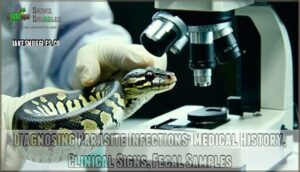This site is supported by our readers. We may earn a commission, at no cost to you, if you purchase through links.

Snake parasite treatment typically involves medications like permethrin for external parasites (those pesky mites) or ivermectin for internal issues.
Your vet will likely prescribe specific treatments based on fecal tests or visual inspection.
Meanwhile, thoroughly clean and disinfect your snake’s enclosure—parasites are like unwelcome houseguests who’ll keep returning if you don’t address their hideouts.
Regular quarantine procedures for new reptiles and proper hygiene practices are your best defense against these troublemakers.
The right combination of medication, environmental management, and preventative care can make these uninvited critters a thing of the past.
Table Of Contents
- Key Takeaways
- Identifying Snake Parasites
- Risks and Consequences of Snake Parasites
- Managing Snake Parasites
- Treatment Options for Snake Parasites
- Preventing Snake Parasites
- Advanced Diagnostic Techniques for Snake Parasites
- Future Directions in Snake Parasite Treatment
- Frequently Asked Questions (FAQs)
- How to treat parasites in snakes?
- What is the best dewormer for snakes?
- How do I know if my snake has parasites?
- Can you deworm a snake?
- How do you treat a snake infection?
- How do you treat septicemia in a snake?
- How do you get rid of parasites in reptiles?
- How do you treat a parasite in a snake?
- How do I know if my snake has a parasite?
- How often should I check for snake parasites?
- Conclusion
Key Takeaways
- You’ll need specific medications based on parasite type – permethrin for external parasites like mites and ivermectin or fenbendazole for internal parasites, all properly dosed based on your snake’s weight.
- You must thoroughly clean and disinfect your snake’s enclosure using reptile-safe products to eliminate parasite eggs and prevent reinfestation, as parasites can quickly spread to other reptiles.
- You should quarantine new snakes for 30-90 days and perform regular fecal testing every 3-6 months to catch parasites early before they cause serious health issues like weight loss, lethargy, or respiratory problems.
- You can prevent many parasite issues by feeding pre-killed frozen prey instead of live food, as freezing kills potential parasites that could otherwise infect your snake.
Identifying Snake Parasites
You’ll need to examine your snake carefully for both visible parasites like mites on the skin and hidden ones that cause symptoms such as weight loss or unusual stools.
Early detection of these unwelcome hitchhikers can make treatment much easier, so don’t wait until your scaly friend starts showing serious signs of illness.
Common External Parasites: Mites and Ticks
Noticing tiny black dots around your snake’s eyes or scales? You’re likely dealing with external parasites. Snake mites appear as moving specks (smaller than a pinhead), while ticks attach more visibly to your reptile’s skin.
Watch for infestation signs like excessive soaking, restlessness, or rubbing against enclosure items.
When it comes to treatment options, specialized reptile-safe acaricides work best for mites, while careful tick removal requires tweezers and steady hands.
Prevention strategies include regular enclosure cleaning, quarantining new animals, and using preventative treatments.
Don’t ignore these parasites—they can cause anemia, skin irritation, and transmit diseases that could seriously harm your slithery friend.
Common Internal Parasites: Helminths and Protozoal Diseases
While mites attack from the outside, the real troublemakers lurk within. Your snake might harbor silent stowaways—internal parasites that cause serious damage.
These microscopic invaders come in two main forms:
- Helminths (worms) – roundworms, hookworms, and pinworms that multiply rapidly in poor conditions
- Protozoal parasites – single-celled organisms causing intestinal disease
- Cryptosporidia – particularly difficult parasites to eliminate, even with treatment
Regular fecal testing is your best defense against these hidden threats.
Symptoms of Parasite Infections: Poor Appetite, Weight Loss, Vomiting
Your snake’s body tells a clear story when parasites strike.
Early detection of symptoms saves lives. Watch for decreased appetite or complete refusal of meals, steady weight loss despite normal feeding, and occasional regurgitation of food.
You might notice visible parasites in stool or vomit. Don’t ignore lethargy, dull skin, or breathing difficulties – these symptom overlaps often point to parasitic invaders.
Remember, what looks like simple appetite loss causes may signal a serious infestation requiring immediate attention from your exotic vet.
Diagnosing Parasite Infections: Medical History, Clinical Signs, Fecal Samples
Accurate diagnosis forms the foundation of effective snake parasite treatment.
Start with your pet’s history—recent stress or diet changes matter.
Watch for clinical signs like unusual discharge or lethargy.
Collect a fresh fecal sample (morning samples work best) for microscopic examination by your vet.
This microscopic examination reveals hidden threats that clinical observation alone might miss.
This parasitological screening reveals hidden threats that clinical observation alone might miss.
Don’t wait—early diagnosis saves reptile lives!
Risks and Consequences of Snake Parasites
Your snake’s health is at serious risk when parasites take hold, potentially causing weight loss, respiratory problems, and even death if left untreated.
These harmful invaders can quickly spread through direct contact with infected reptiles or from contaminated food and water sources, turning your healthy pet into a struggling companion before you even notice the symptoms.
They can cause significant harm, leading to a decline in your pet’s health, and it is crucial to address the issue promptly to prevent further complications.
Impact on Snake Health and Well-being
The hidden toll of parasites on your snake’s health can be devastating.
When these unwelcome invaders take hold, they trigger immune suppression and cause organ damage that substantially impacts your pet’s quality of life.
- Reduced lifespan becomes a heartbreaking reality as parasites drain essential nutrients
- Reproductive issues emerge, threatening your snake’s legacy
- Behavioral changes signal your reptile’s silent suffering
Don’t ignore snake parasite symptoms like weight loss or abnormal shedding, as they can lead to a significantly reduced lifespan.
Transmission of Parasites: Direct Contact, Contaminated Food, and Water
While parasites affect your snake’s health, understanding how they spread is key to prevention.
Parasites invade through multiple pathways:
- Direct contact with infected snakes or contaminated surfaces
- Prey contamination from live or improperly prepared food
- Water sources harboring microscopic pathogens
- Fecal transmission when cleaning isn’t thorough
- Environmental spread through bedding or decorations
You’ll stop both internal and external parasites by maintaining terrarium hygiene and feeding prekilled frozen prey.
Simple changes make a big difference!
Managing Snake Parasites
You’ll need to act quickly when parasites attack your snake, combining proper medications with thorough habitat cleaning to eliminate these unwelcome guests.
Regular fecal testing and wellness checks can catch these troublemakers early, ensuring your scaly friend stays healthy and active for years to come.
Quarantine and Parasitological Screening: Essential for Imported Snakes
While your snake might look healthy, it could be an asymptomatic carrier of dangerous hitchhikers.
Quarantine every new reptile for 30-90 days, especially imported ones with high zoonotic potential.
During this time, implement thorough screening protocols like fecal tests to detect both external and internal parasites.
Think of quarantine as your first defense line—it’s like a customs checkpoint that keeps unwanted visitors from spreading to your other pets.
Anthelmintic Therapy: Killing or Eliminating Parasites
Now that you’ve quarantined your new snake, it’s time to tackle those unwelcome hitchhikers.
Anthelmintic therapy is your secret weapon against internal parasites.
These specialized dewormers target and eliminate worms without harming your scaly friend.
Your vet will calculate the perfect dosage based on your snake’s weight and condition.
As these drugs target parasitic worm infections, they can be essential for a reptile’s recovery.
Watch for treatment efficacy by monitoring your pet’s stool quality and energy levels.
Be aware that dewormer resistance can develop with improper use, so always complete the full treatment course.
Some medications may involve off-label uses, making professional guidance crucial for avoiding dangerous drug interactions.
Proper Husbandry: Reducing The Risk of Parasitic Infections
Your snake’s living conditions are the first line of defense against parasites.
Proper husbandry keeps parasites at bay, ensuring your snake thrives in a clean, safe, and stress-free environment.
Proper husbandry dramatically reduces infection risks through:
- Daily spot cleaning and weekly deep enclosure sanitation to remove waste
- Maintaining ideal temperature control and humidity levels specific to your snake species
- Feeding high-quality, parasite-free prey (frozen-thawed is safest)
- Implementing strict quarantine protocols for new snakes (30-90 days minimum)
These simple practices create an environment where parasites struggle to thrive, keeping your scaly friend healthy.
Regular cleaning requires a suitable enclosure cleaner, and by following these steps, you can ensure a safe and clean environment for your snake, which is essential for its overall well-being.
Ongoing Monitoring: Regular Fecal Testing and Wellness Exams
Commit to proactive healthcare through regular fecal testing and wellness exams for your pet snake.
Veterinary partnerships are essential—aim for fecal frequency of every 3-6 months, increasing for new or sick reptiles.
These routine health screenings catch problems before they worsen, and the wellness benefits are clear: early detection of parasites saves lives through parasitological screening.
Just like changing your car’s oil prevents engine failure, parasitological screening prevents costly health emergencies.
Treatment Options for Snake Parasites
You’ll need to act quickly when your scaly friend shows signs of parasites, as effective treatments like anthelmintics and antibiotics can make the difference between recovery and decline.
Modern snake parasite treatments combine medication with supportive care including fluid therapy and nutritional support, giving your reptile the best chance to slither back to health.
Anthelmintics: Dewormers for Killing or Eliminating Parasites
After managing your snake’s parasites, you’ll need effective treatment. Anthelmintics (dewormers) are your frontline defense against internal parasites, working by paralyzing or starving these unwelcome guests.
Your snake deworming success depends on:
- Proper dosage calculation based on weight
- Choosing the right administration methods (oral, injectable)
- Following veterinarian-prescribed treatment schedules
- Monitoring for anthelmintic resistance
Watch for unusual behavior after treatment—it might indicate drug interactions or side effects. You can find various snake dewormers online. Most snakes tolerate dewormers well when properly dosed.
Antibiotics and Antiviral Medications: Treating Secondary Infections
When your pet snake battles parasites, it often needs help against secondary bacterial infections.
Vets commonly prescribe enrofloxacin or ceftazidime to tackle these unwelcome hitchhikers.
For viral infections, medications like acyclovir may be applied directly to affected areas.
Remember, antibiotics won’t fight viruses – knowing the difference is key!
Drug resistance is a growing concern, so always follow your vet’s exact dosage guidelines.
Combination therapies using amikacin with metronidazole often work best for stubborn infections.
Never self-medicate your reptile friend – professional guidance guarantees effective treatment.
Supportive Care: Fluid Therapy, Nutritional Support, and Wound Care
Beyond antibiotics, your snake needs thorough care when battling parasites.
Fluid administration prevents dangerous dehydration, while specialized nutritional formulas support recovery.
You’ll need to master gentle force feeding techniques if your reptile refuses food.
For wounds, proper management includes cleaning and applying vet-recommended treatments.
Don’t overlook pain management—your silent friend can’t tell you when it hurts.
Hydration therapy and consistent veterinary intervention dramatically improve your snake’s chances of bouncing back with proper management.
Preventing Snake Parasites
You’ll protect your scaly friend from harmful parasites by establishing a consistent prevention routine that includes regular enclosure cleaning, proper quarantine procedures, and feeding pre-killed prey.
Just like washing your hands prevents human illness, maintaining strict hygiene in your snake’s habitat creates a barrier against those microscopic invaders that can quickly turn your pet’s health upside down, which is why a consistent prevention routine is crucial.
Regularly Inspecting Reptiles for Signs of Parasites
Regular inspection is your first line of defense against snake parasites.
Examine your pet’s scales carefully for skin abnormalities like redness or discoloration. Watch for behavioral changes such as excessive soaking or unusual movement patterns.
Visual cues like tiny black dots (mites) require immediate snake parasite treatment. Early detection through weekly scale examination substantially increases treatment success.
Don’t wait for obvious symptoms—by then, parasites may have multiplied beyond easy control.
Regular fecal parasite tests are also essential for detecting internal parasites.
Isolating Infected Reptiles: Preventing Cross-Infection
After spotting parasite signs, swift isolation becomes your next defense line. Once you’ve identified an infected snake, separate it immediately to protect your other reptiles.
- Maintain strict quarantine for 30-90 days with dedicated tools and equipment
- Create physical barriers between enclosures to prevent cross-contamination risks
- Monitor isolated snakes daily for improvement or worsening symptoms
- Implement thorough hand-washing before and after handling each reptile
These isolation protocols dramatically reduce the chance of parasites spreading throughout your collection, which is a critical step in maintaining a healthy reptile environment with proper prevention measures.
Practicing Good Hygiene: Cleaning and Disinfecting Enclosures
After isolating sick reptiles, your next defense is cleanliness. A clean enclosure dramatically reduces parasite risks!
| Cleaning Task | Frequency | Products |
|---|---|---|
| Spot cleaning | Daily | Water/paper towels |
| Substrate change | Weekly | Fresh substrate |
| Deep disinfection | Monthly | Reptile-safe disinfectant |
Choose the right disinfectant for environmental decontamination—many household cleaners are toxic to reptiles. Using a safe disinfectant is essential for reptile health.
Don’t forget water hygiene! Change and clean water dishes daily to prevent bacterial growth that can weaken your snake’s immune system.
Feeding Pre-Killed Frozen Prey: Reducing The Risk of Parasites
Why take risks with live prey when frozen alternatives offer better protection? Freezing kills parasites that might otherwise infect your snake through live food sources.
Pre-killed, frozen prey maintains excellent nutritional value while eliminating parasite threats from wild-caught rodents. You’ll need to follow safe thawing practices – never microwave! – but the cost-benefit analysis clearly favors this approach.
Remember, effective snake parasite prevention starts with what goes into your pet’s mouth. Smart prey source selection is your first line of defense in thorough snake parasite treatment.
Advanced Diagnostic Techniques for Snake Parasites
You’ll need cutting-edge diagnostic tests like PCR and imaging scans to spot those sneaky parasites your snake might be hiding.
Modern vet clinics now offer molecular testing and specialized scans that can detect even the most elusive parasites before they cause serious harm to your scaly friend.
Molecular Diagnostics: PCR and DNA Sequencing
After preventing infections, you’ll want the most accurate diagnosis possible.
PCR and DNA sequencing revolutionize snake parasite treatment by amplifying tiny amounts of genetic material for precise identification.
These molecular techniques detect parasites that traditional methods miss, revealing both common and novel parasites with unmatched accuracy.
You’re not just getting a diagnosis—you’re uncovering the exact species and potential resistance patterns, ensuring targeted treatment for your scaly friend.
Imaging Techniques: Radiography, Computed Tomography, and Magnetic Resonance Imaging
Veterinarians use imaging techniques as windows into your snake’s body, revealing hidden parasites.
Radiography captures basic internal views, while CT scans offer detailed cross-sections showing parasite locations.
MRI applications excel at soft tissue visualization when standard techniques fail.
Though costs vary, technique comparison shows each has value in reptile vet medicine for accurate snake parasite diagnosis.
Serological Tests: Enzyme-Linked Immunosorbent Assay and Western Blot
Blood tests can dig up evidence of parasites your reptile might be hiding.
Serological tests like ELISA and Western Blot detect antibodies your snake produces when fighting parasites.
- ELISA applications: Detects specific antibody-antigen reactions, helpful when fecal testing misses infections
- Western Blotting: Confirms parasite identity with greater precision than ELISA alone
- Antibody Detection: Shows current or past infections, guiding your reptile vet’s treatment plan
- Diagnostic Accuracy: Varies by parasite type – some show clear results while others remain elusive
These tests require specialized labs but offer vital insights when traditional methods fall short.
Future Directions in Snake Parasite Treatment
You’ll soon see exciting breakthroughs in treatment options as scientists develop more targeted medications that combat resistant parasites without harming your scaly friend.
Veterinary researchers are also creating faster diagnostic tests that can identify multiple parasites from a single sample, making it easier for you to protect your snake’s health before problems slither out of control, with faster diagnostic tests and targeted medications being key to effective care.
Development of New Anthelmintics and Antiparasitic Medications
While examining snake parasites under microscopes has improved, the real breakthrough lies in new medications for treatment.
Research teams are developing innovative anthelmintics to combat drug resistance that’s becoming common in traditional treatments.
Your reptile’s health depends on these advancements in veterinary parasitology.
Scientists are exploring natural compounds that target parasites in ways conventional drugs can’t.
These novel targets mean better endoparasiticides with fewer side effects.
Delivery methods are evolving too—making medications easier to administer to your scaly friend.
Some promising areas include:
Immunotherapy
anthelmintic therapy
Improving Diagnostic Techniques: Increased Sensitivity and Specificity
While new drugs are promising, spotting parasites early makes all the difference.
Tomorrow’s diagnostics will be game-changers for your snake’s health:
- Molecular diagnostics that find parasites DNA before symptoms appear
- Imaging advancements revealing hidden infections through special scans
- Serological assays detecting antibodies in tiny blood samples
- Point-of-care testing providing results during vet visits
Beyond basic fecal testing, these technologies mean faster, more accurate treatment for your scaly friend.
Enhancing Our Understanding of Parasite Biology and Ecology
Through deeper study of parasite lifecycles and host-parasite interactions, you’ll gain powerful insights for treating your snake’s parasites.
Scientists are mapping how these tiny invaders evolve and adapt, which directly impacts treatment effectiveness. Understanding environmental impacts and zoonotic potential isn’t just academic—it’s practical knowledge that helps you protect your pet and prevent future infections.
Implementing quarantine procedures can also halt parasite spread. This research translates to more targeted treatments and prevention strategies you can use at home.
Frequently Asked Questions (FAQs)
How to treat parasites in snakes?
With 5% of snakes testing positive for parasites, you’ll need veterinary-prescribed medications like fenbendazole or ivermectin.
Clean enclosures regularly, quarantine new snakes, and schedule fecal tests every 3-6 months for early detection of parasites.
What is the best dewormer for snakes?
Fenbendazole is your go-to dewormer for most snake parasites.
You’ll also need praziquantel for tapeworms and ivermectin for certain nematodes.
Always consult your vet before treating—they’ll prescribe the right medication and dosage.
How do I know if my snake has parasites?
Watch for appetite loss, weight changes, unusual stools, regurgitation, and visible worms in feces.
You’ll also notice respiratory issues, lethargy, or skin problems.
Regular vet check-ups with fecal tests confirm parasite presence definitively.
Can you deworm a snake?
With 1% of reptiles testing positive for parasites, you can definitely deworm your snake.
Your vet can prescribe specific anthelmintics like fenbendazole or ivermectin based on the parasite type identified through fecal testing.
How do you treat a snake infection?
To treat your snake’s infection, consult a vet who’ll likely prescribe antibiotics, antifungals, or antiparasitics depending on the cause.
You’ll need to clean the enclosure thoroughly and follow medication instructions precisely.
How do you treat septicemia in a snake?
Septicemia in snakes requires immediate veterinary care.
You’ll need to administer injectable antibiotics, provide fluid therapy, and potentially force-feed your snake.
Keep its environment clean and maintain proper temperature during recovery.
How do you get rid of parasites in reptiles?
Getting to the root of the problem requires regular deworming medications, enclosure disinfection, and veterinary check-ups. You’ll need anthelmintics like fenbendazole or ivermectin, plus proper hygiene to eliminate parasites completely.
How do you treat a parasite in a snake?
Start by isolating the snake to prevent spreading.
Use vet-prescribed dewormers like fenbendazole for internal parasites or afoxolaner for mites.
Maintain strict hygiene, clean the enclosure thoroughly, and follow your vet’s instructions closely.
How do I know if my snake has a parasite?
Like tiny invaders under your snake’s radar, parasites reveal themselves through weight loss, poor appetite, abnormal stools, and lethargy.
You’ll also notice skin issues, respiratory problems, or visible worms in feces, which can be considered abnormal stools.
How often should I check for snake parasites?
You should check your snake for parasites every 3-6 months with regular fecal testing.
Increase checks to monthly for new or sick snakes.
Watch daily for behavior changes that might signal parasite problems.
Conclusion
Will your scaly friend thrive parasite-free?
Remember that effective snake parasite treatment requires vigilance and prompt action.
By following proper quarantine procedures, maintaining pristine enclosures, and working closely with your veterinarian, you’ll give your reptile the best defense against these troublesome invaders.
Don’t wait until symptoms worsen—early intervention with appropriate medications and environmental management is key.
With consistent care and regular health monitoring, your snake can enjoy a long, parasite-free life.
- https://www.ncbi.nlm.nih.gov/pmc/articles/PMC3118381/
- https://www.outbackreptiles.com/2020/01/should-i-treat-my-wild-caught-animal-for-parasites/
- https://bpp.oregonstate.edu/plant-parasitic-nematodes-grasses
- https://my.clevelandclinic.org/health/drugs/22945-antiparasitic-drugs
- https://www.sciencedirect.com/science/article/pii/S221132072030018X

















